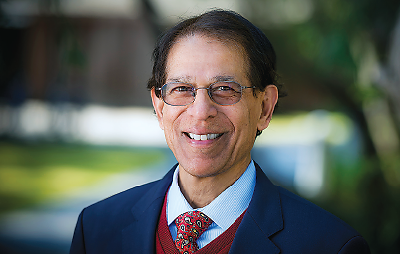Jeste Works to Reverse Negative Notions of Aging
Abstract
A new Center on Aging at the University of California, San Diego, will promote innovative research, education, and policy to improve the quality of life for the growing numbers of senior citizens in the United States.
“It’s getting better all the time,” Paul McCartney sang in the Beatles’ 1967 hit, “Getting Better.” This message as it applies to growing older is strongly endorsed by geriatric neuropsychiatrist Dilip Jeste, M.D., who became director of the newly established Center on Healthy Aging and Senior Care at the University of California, San Diego (UCSD), in May.

Dilip Jeste, M.D., would like to use the new Center on Healthy Aging and Senior Care at the University of California, San Diego, to enhance the “latent capabilities” of older individuals.
Jeste, who is the Estelle and Edgar Levi Chair in Aging and director of the Sam and Rose Stein Institute for Research on Aging at UCSD, also became the first associate dean for Healthy Aging and Senior Care at UCSD in May. He is also a past president of APA.
Jeste envisions the center as a place in which experts from different fields and multiple perspectives can study both the negative and positive aspects of aging. He is a strong proponent of positive psychiatry, in which the psychiatrist focuses on effecting positive behavior change, emphasizing the patient’s strengths, and improving the patient’s quality of life. Jeste has written a book on positive psychiatry, which he said will be available in time for the 2015 APA annual meeting next May.
While the negative aspects of aging are familiar to most, the positive side of aging deserves to be recognized and further explored, Jeste said in an interview with Psychiatric News. “When I first began conducting research on aging as the director of the Institute for Research on Aging at UCSD more than two decades ago, old age was generally viewed in completely negative terms,” he said. “People often thought of the three Ds—disease, dementia, and death. But recently, we’ve found that although older people have more physical impairments than their younger counterparts, they report better quality of life and enhanced well-being. I call it the paradox of aging.”
In the February 2013 American Journal of Psychiatry, Jeste and his colleagues reported that when they surveyed a community sample of more than 1,000 respondents over age 50, older age was associated with higher self-reported ratings of successful aging, despite worse physical and cognitive functioning. “We found that significant predictors of successful psychosocial aging were resilience and optimism,” Jeste noted.
Researchers at the Center on Healthy Aging and Senior Care will also study the impact of aging on people with disorders such as schizophrenia, posttraumatic stress disorder, HIV, diabetes, and cancer and reasons that some people do better than others as they age.
Jeste also noted that as part of the center’s mission and work, educational grants will provide unique learning opportunities for low-income, ethnically diverse high school students and for undergraduate, graduate, and medical students, as well as other trainees, who will conduct projects under the mentorship of researchers in aging.
Currently, there are almost 40 million people in the United States over age 65. By 2030, this number is expected to exceed 70 million. “Society is not prepared for what many are calling the ‘silver tsunami,’ ” Jeste said. “We do not have enough specialists in geriatric medicine or geriatric psychiatry, and the shortage will become even more dire in the years ahead.”
Jeste refers instead to the influx of aging baby boomers in more positive terms—the “golden wave”—and says that the new center will serve as a think tank, with the focus extending beyond health care research and into areas such as policy, technology, and urban planning. “The ultimate question before us is how can we make society more age-friendly for our older citizens,” he said.
Jeste’s co-chair of the new center, Dan Blazer, M.D., Ph.D., told Psychiatric News that “this cohort of older Americans will be much more technologically savvy than ever before,” and so could benefit from interactive technological advances meant to make their lives easier. Blazer is J.P. Gibbons Professor of Psychiatry and Behavioral Sciences at Duke University Medical Center and is on the External Advisory Board of the Stein Institute for Research on Aging at UCSD.
Blazer said the installation of video cameras in the homes of older people with mobility issues as a type of monitoring system for physical therapists or others helping them with certain tasks is an instance in which technology may help make life better for older individuals. Another might be cars equipped with sensors that activate an alarm when the driver steers off course, he noted. A social networking site for seniors would also help connect them to others and keep them from being isolated, as long as it is not their sole form of interaction, he said.
But how to make such advances a reality? This is of great concern to Blazer.
“The challenges this older generation will face are significant,” he pointed out. “Aging baby boomers are spoken of in very negative terms—for years now, we have been told they will be using all of the Social Security funding and that they are a drain on society. This is nothing new.”
Blazer said the challenge is to capture the imagination of the public, government agencies, religious organizations, and community agencies so that funding will be made available to study ways to make life better for seniors. “We need to convey the message that ‘there is no time to waste—this is you and me in 10 years,’ ” Blazer said.
Jeste added that no group of professionals is more perfectly poised to optimize the functioning of older Americans than psychiatrists. “We are the behavior experts, after all,” he emphasized. “We must highlight the fact that older Americans are society’s foundation—they are great role models and mentors for younger generations.” ■



